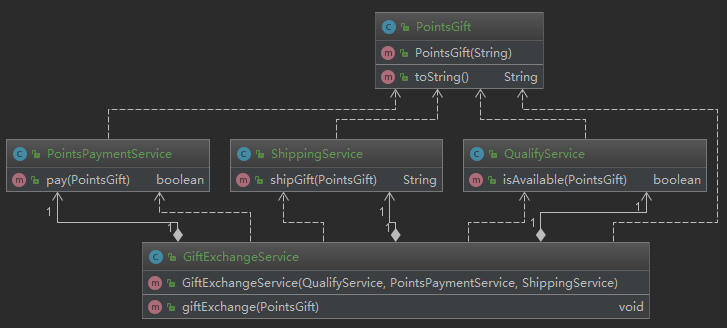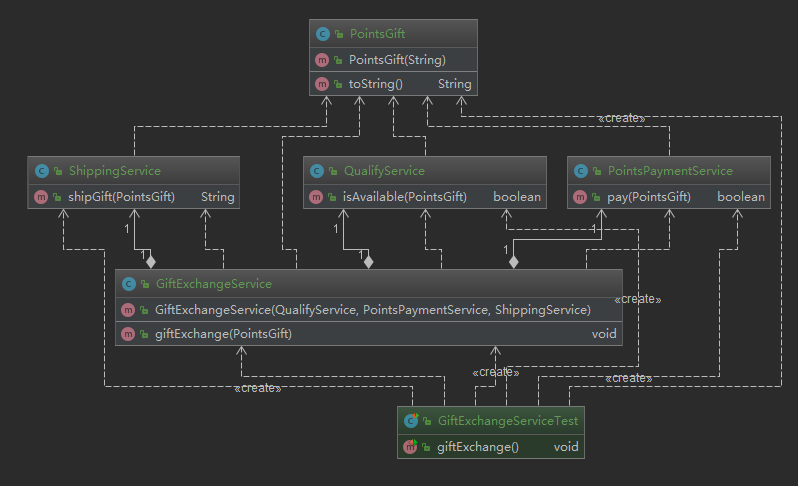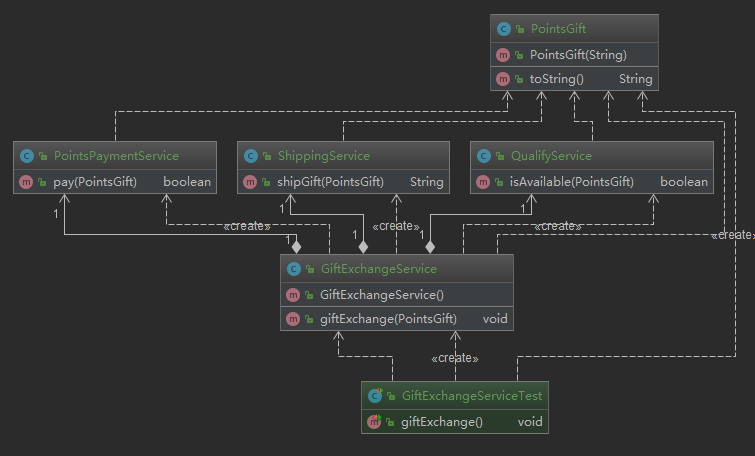# 外观模式
定义:又叫门面模式,提供了一个统一的接口,用来访问子系统中的一群接口
特点:定义了一个高层接口,让子系统更容易使用
类型:结构型
# 适用场景
- 子系统越来越复杂,增加外观模式提供简单调用接口
- 构建多层系统接口,利用外观对象作为每层的入口,简化层间调用
# 优点
- 简化了调用过程,无需了解深入子系统,防止带来风险
- 减少系统以来、松散耦合
- 更好的划分访问层次
- 符合迪米特法则,即最少知道原则
# 缺点
- 增加子系统、扩展子系统行为容易引起风险
- 不符合开闭原则
# 相关设计模式
中介则模式
- 中介则模式:关注的是子系统内部之间的交互
- 外观模式:关注的是外界和子系统的交互
单例模式:通常可以吧外观对象做成单例使用
抽象工程:外观类可以通过工厂类获取子系统的实例
# 代码
假设一个场景:慕课网的积分兑换,那么可能的子系统有:
- 库存校验系统
- 积分支付系统
- 物流系统
/**
* 积分礼物
*
* @author : zhuqiang
* @date : 2018/12/24 9:47
*/
public class PointsGift {
private String name;
public PointsGift(String name) {
this.name = name;
}
@Override
public String toString() {
return "PointsGift{" +
"name='" + name + '\'' +
'}';
}
}
2
3
4
5
6
7
8
9
10
11
12
13
14
15
16
17
18
19
20
/**
* 资格校验:积分校验,库存校验
*
* @author : zhuqiang
* @date : 2018/12/24 9:49
*/
public class QualifyService {
public boolean isAvailable(PointsGift pointsGift) {
System.out.println("校验" + pointsGift + " 积分通过,库存通过");
return true;
}
}
2
3
4
5
6
7
8
9
10
11
12
/**
* 积分支付服务
*
* @author : zhuqiang
* @date : 2018/12/24 9:48
*/
public class PointsPaymentService {
public boolean pay(PointsGift pointsGift) {
System.out.println(pointsGift + " 支付扣减积分成功");
return true;
}
}
2
3
4
5
6
7
8
9
10
11
12
/**
* 物流服务
*
* @author : zhuqiang
* @date : 2018/12/24 9:52
*/
public class ShippingService {
public String shipGift(PointsGift pointsGift) {
// 物流系统对接逻辑
System.out.println(pointsGift + " 进入物流系统");
String shippingOrderNo = "6666";
return shippingOrderNo;
}
}
2
3
4
5
6
7
8
9
10
11
12
13
14
三个子系统服务,外部如果要使用,必须知道流程,这个时候就可以封装一个外观服务; 一个积分礼物兑换的服务暴露,这也符合迪米特法则,即最少知道原则;
/**
* 外观模式服务
*
* @author : zhuqiang
* @date : 2018/12/24 10:00
*/
public class GiftExchangeService {
private QualifyService qualifyService;
private PointsPaymentService pointsPaymentService;
private ShippingService shippingService;
public GiftExchangeService(QualifyService qualifyService, PointsPaymentService pointsPaymentService, ShippingService shippingService) {
this.qualifyService = qualifyService;
this.pointsPaymentService = pointsPaymentService;
this.shippingService = shippingService;
}
/**
* 礼物兑换
*/
public void giftExchange(PointsGift pointsGift) {
if (qualifyService.isAvailable(pointsGift)
&& pointsPaymentService.pay(pointsGift)) {
String shippingOrderNo = shippingService.shipGift(pointsGift);
System.out.println(pointsGift + " 返回的订单号 " + shippingOrderNo);
}
}
}
2
3
4
5
6
7
8
9
10
11
12
13
14
15
16
17
18
19
20
21
22
23
24
25
26
27
28

可以看到外观服务组合了三个子系统(菱形)
测试代码
@Test
public void giftExchange() {
GiftExchangeService giftExchangeService = new GiftExchangeService(new QualifyService(), new PointsPaymentService(), new ShippingService());
giftExchangeService.giftExchange(new PointsGift("iphone8"));
}
=====================
校验PointsGift{name='iphone8'} 积分通过,库存通过
PointsGift{name='iphone8'} 支付扣减积分成功
PointsGift{name='iphone8'} 进入物流系统
PointsGift{name='iphone8'} 返回的订单号 6666
2
3
4
5
6
7
8
9
10
11

如果上图,客户端其实是不需要创建子系统的,在这里不是分布式的服务所以能看到客户端创建了子系统; 抛开这个因素,可以看到,客户端只和外观类交互了;
来模拟下上面所说的,让外观类去创建子系统服务,就如下图了,下图才是外观类使用的一个标准类图: 客户端只和外观类交互

对于不经常变化的来说,直接使用实体外观类,如果对于经常变化的,就需要使用抽象外观类了
# 外观模式源码解析
springjdbc+myabtis+tomcat
org.springframework.jdbc.support.JdbcUtils
public static void closeConnection(@Nullable Connection con) {
if (con != null) {
try {
con.close();
}
catch (SQLException ex) {
logger.debug("Could not close JDBC Connection", ex);
}
catch (Throwable ex) {
// We don't trust the JDBC driver: It might throw RuntimeException or Error.
logger.debug("Unexpected exception on closing JDBC Connection", ex);
}
}
}
2
3
4
5
6
7
8
9
10
11
12
13
14
该类的方法基本上都是对 java.sql 的外观封装,如上面关闭连接
org.apache.ibatis.session.Configuration
该类中 newXX 的方法就是外观方法
public ParameterHandler newParameterHandler(MappedStatement mappedStatement, Object parameterObject, BoundSql boundSql) {
ParameterHandler parameterHandler = mappedStatement.getLang().createParameterHandler(mappedStatement, parameterObject, boundSql);
parameterHandler = (ParameterHandler) interceptorChain.pluginAll(parameterHandler);
return parameterHandler;
}
2
3
4
5
# tomcat
源码下载 (opens new window) 强选择该页面下的 Source Code Distributions 部分中的 zip。解压之后导入 IDEA 查看。
org.apache.catalina.connector.Request org.apache.catalina.connector.RequestFacade
Request 是 javax.servlet.http.HttpServletRequest 的实现; RequestFacade 是对 Request 的一个外观类,在外部获取 getRequest 的时候,返回的就是这个外观类
/**
* The facade associated with this request.
*/
protected RequestFacade facade = null;
/**
* @return the <code>ServletRequest</code> for which this object
* is the facade. This method must be implemented by a subclass.
*/
public HttpServletRequest getRequest() {
if (facade == null) {
facade = new RequestFacade(this);
}
if (applicationRequest == null) {
applicationRequest = facade;
}
return applicationRequest;
}
2
3
4
5
6
7
8
9
10
11
12
13
14
15
16
17
18
19
比较下 外观类 和具体类的方法实现
org.apache.catalina.connector.Request#getAttribute
@Override
public Object getAttribute(String name) {
// Special attributes
SpecialAttributeAdapter adapter = specialAttributes.get(name);
if (adapter != null) {
return adapter.get(this, name);
}
Object attr = attributes.get(name);
if (attr != null) {
return attr;
}
attr = coyoteRequest.getAttribute(name);
if (attr != null) {
return attr;
}
..... 省略很多代码
2
3
4
5
6
7
8
9
10
11
12
13
14
15
16
17
18
19
20
org.apache.catalina.connector.RequestFacade#getAttribute
@Override
public Object getAttribute(String name) {
if (request == null) {
throw new IllegalStateException(
sm.getString("requestFacade.nullRequest"));
}
return request.getAttribute(name);
}
2
3
4
5
6
7
8
9
10
11
在 TOMCAT 源码中大量的使用了外观模式